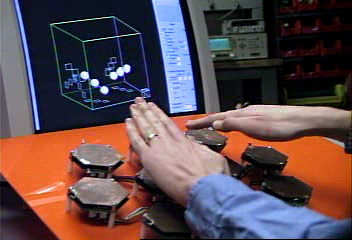Original URL: https://www.theregister.com/2010/02/22/tricorder_motion_tracker_gear_funded/
Tricorder/Aliens-motion-tracker handscanner kit gets $6m
3D air-bongo mouse shark tech in DARPA cashgasm
Posted in Science, 22nd February 2010 15:37 GMT
Roguish Pentagon kill-nerds have decided to spend more than $6m on a miraculous handheld scanner along the lines of a Star Trek Tricorder or Aliens Colonial Marine motion-tracker. The through-walls people detector will work in the same way as the mysterious brain-slime electrofield senses of sharks and manta rays.
Now we just need a gizmo that foreshadows the dramatic necessity for us to die one by one.
The new technology has been dubbed E-FED, or Electric Field Detector, by those behind it. The idea would be to detect the bioelectrical fields produced by all living things using sensitive electronics. This would offer detection and tracking through walls or other barriers, and allows a sensor to easily work in three dimensions.
Such methods are already employed in real life, by elasmobranches (sharks and rays). Slime-filled canals in the creatures' heads - known as the "ampullae of Lorenzini" - let them sniff out the electric field of bottom-feeding flatfish concealed in mud or sand, leading to a tasty treat for the prowling elasmobranch.
Other applications of electrofield detection have already been made by human technology, perhaps most famously by the eccentric researchers of MIT's Media Lab. They have proposed (and built prototypes of) so-called "Taufish" or "Lazyfish" devices. These can detect a human hand situated above a sensor, allowing a "3D mouse" gesture based computer interface.
MIT air-bongo mouse will never do for Starfleet. Or DARPA
But existing kit, whether shark or MIT style, can't reach far from the detector. More range is required before Starfleet or the Colonial Marines would be interested.

The electronic bongos were surprisingly difficult to master
Of course, once we're talking about transforming today's relatively humdrum US military into its possible science fiction successor, there's really only one agency to call. That is DARPA, the military research arm where they sneer at those who are merely on the bleeding edge: the edge where they live is so sharp that mere blood loss or severed limbs are nothing. If you weren't careful with it you might split atoms and start a devastating nuclear chain reaction in your own finger. An atom-splitting or fissioning edge, as it were.
And DARPA has answered the call of which we were speaking before we digressed slightly, announcing last week that it would shell out a cool $6,425,207 to Ohio tech house SRICO for a functioning E-FED.
According to the warboffins:
Electric field detectors are relatively large (especially at lower frequencies) so that compact detectors and arrays are not possible ...DARPA is seeking innovative research proposals for E-FED technologies that will enable the fabrication of dense detector arrays to achieve high spatial resolution of the electric field as well as high sensitivity.
Proposal solutions resulting in smaller and lower power sensors will be given preference to otherwise equally competitive proposals ... high sensitivity in a small form factor must be provided.
Full details on the E-FED project are avilable here in pdf: there are also some circuitry, code downloads and other tech details from MIT for interested garage Q-Branch enthusiasts here. ®